Entries tagged as ‘teaware’
September 19, 2008 · 5 Comments
I have an incredible fizzing pot
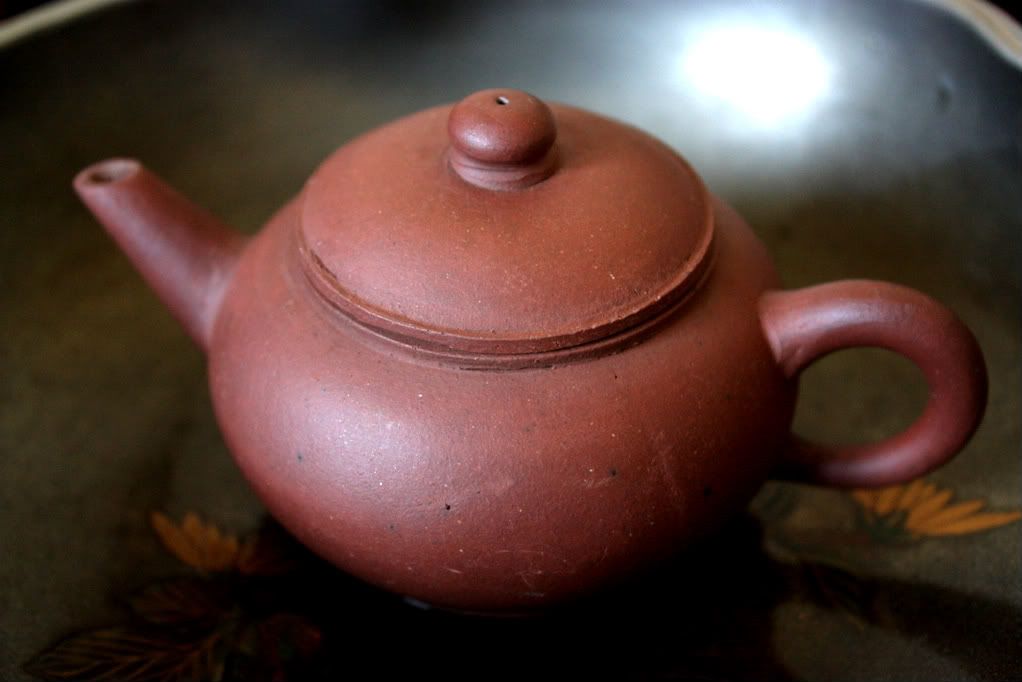
This thing is a little strange. It fizzes when I first pour hot water into and over it. What is it is that there are some smallish holes on the surface of the pot that will, essentially, expel air as it expands with heat. The pot will literally fizz when I first warm it up. Subsequently, the fizz won’t happen, or is at least a lot more subdued.

You can sort of see the holes in the closeup. I think this pot is not made with yixing clay, but something else, as I don’t think Yixing clay generally has such low density. It has definitely turned darker over time as I use it more — I’ve been brewing young puerh in it, and it has worked quite well for me.
There has been some hullabaloo recently on Teachat about pots made with clay that’s not from Yixing…. but last time I checked, non-Yixing clay can make good tea. You have Japanese clay pots of various ilk, you have Shantou pots, and then you have mystery pots like this one…
As long as the tea comes out good… does it really matter?
Categories: Objects · Old Xanga posts
Tagged: teaware, yixing
These days I’m drinking not much more than traditionally stored puerh, cheap Wuyi, and the like. I am pretending to be busy with work…
What I have been doing though is sometimes starting out a tea with the tetsubin, and then switching over to the silver kettle later on. It’s an interesting contrast, and predictable in its effect. The silver kettle water makes tea that comes out cleaner with much higher fragrance. The tetsubin water is always heavier.
I do need to test this out with, say, a stainless steel kettle in order to have some sort of a control to see what comes of that. I have also been told by a friend who has tried different silver kettles that they seem to have different effects — thinner silver, he says, makes better water, which is an interesting observation.
There is one hazard with silver kettles though — they are VERY hot to the touch, which makes sense, since silver is a fantastic heat conductor. It does mean that when using it, it’s easy to burn yourself if you’re not careful, and water will cool very quickly if it’s not kept warm.
I do wonder how Japanese used it back before electric ways of heating things — did they keep it on a charcoal brazier? Without heat? What happens?
Categories: Information · Objects · Old Xanga posts
Tagged: silver, teaware
It can make my $3 huangjingui taste like $30 huangjingui.
Well, maybe I’m exaggerating a little, since the tea is still weak and a bit flat, but at the same time, I got the most incredible throatiness for what is certainly a mediocre tea today, and the only variable is the kettle used. For people like me who look for such things and appreciate them in tea, it’s a nice plus. The taste also changed a bit — cleaner, as I’ve mentioned before, and a little sweeter. Tetsubins can be heavy sometimes for the lighter teas, and huangjingui is on the light side of things.
And for those who remain skeptical — the difference should be obvious, not subtle. My friend who owns a silver kettle said the same when he first tried it — he thought it would only be a minor difference, but it turns out the changes are quite dramatic.
This, however, is not an endorsement to go out and buy a $3000 kettle. They’re not worth that much money.
Categories: Information · Objects · Old Xanga posts
Tagged: silver, teaware
I got a heating plate (you can see a corner of it in yesterday’s picture) so I can safely heat my silver kettle without running a high risk of screwing it up. I noticed that a flame will help tarnish the silver, even just a little. I decided I’d like a more even and less risky method of heating the thing.
I brewed some wet stored Vietnamese puerh today, and at first, used a tetsubin. Then, near the end, I switched to the silver kettle…. with a remarkable difference. The fact that they’re different is of course not surprising, but exactly how it’s different and what’s different is, perhaps, still a little startling when drinking it. The tea comes out much cleaner in taste, and also much sweeter. Maybe it loses a little body, but it’s definitely a different tea when using the differently prepared water.
I wonder how the Huangjingui will taste with the silver kettle. Time to experiment.
Categories: Objects · Old Xanga posts
Tagged: silver, teaware

Today I recieved in the mail two beautiful cups as a wedding present from our common sensei. The cups, I believe, have Korean origins. They have a milky white crackled glaze, sort of like Hagi-ware for the Japanese ceramics aficiandos out there, and is quite large. Just large enough, in fact, so that when I put my two chataku together, the lips of the cups just touch, which means no tea wasted when I pour straight from my pot into the cups, gongfu style, splitting the guangyungong bing I brewed today evenly into two cups.
Perfect!

Categories: Objects · Old Xanga posts
Tagged: cups, teaware
I find that among all teas, matcha gives the highest caffeine rush. Yes, I sound like a true addict, but I’m being serious here — most of the time, when I drink a tea I don’t notice the caffeine, not immediately anyway. With matcha, however, I KNOW I just had some caffeine injected into my system — it shows up right away in more measure than one. Yesterday I had some matcha, partly because I only had half an hour to my next appointment, which meant that it was impossible to drink a full sitting of tea, but partly because I wanted to play with my new toy and matcha seems the most appropriate
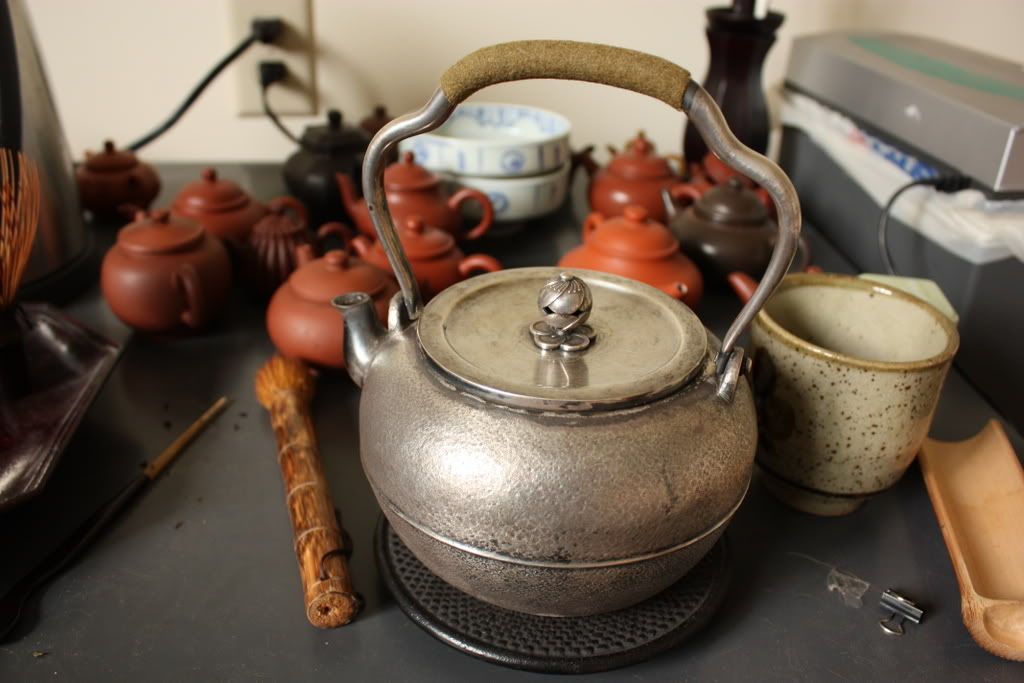
And I noticed, after drinking one bowl of that stuff, that my heart started pumping a little faster, my mind got a little clearer, and I was having a bit of a caffeine buzz. Of course, it probably was more obvious than usual because it was late in the day for my first dose of the stuff (5pm) so it might have accentuated the effects, but regardless, it made me wonder if that’s why so many people like drinking matcha. A friend recently told me that although she is a die-hard coca-cola drinker, she recently took a liking to a new kind of Pepsi. She couldn’t figure out why, until she noticed that Pepsi Max includes, among other things, a double dose of caffeine compared to regular Pepsi. Small wonder that she likes it more.
So, if in need of a caffeine kick, drink lots of matcha.
Categories: Old Xanga posts · Teas
Tagged: green tea, silver, teaware
I think I mentioned a while ago that a friend of mine has asked me to write a column for the magazine he’s editing. I just got a copy today of the first issue, and it has a rather interesting article on the care of Yixing pots. This is advice from a daughter of one of the Yixing pot artists on how to deal with new pots:
1) First use hot water to rinse the pot, both inside and out, and get rid of the dust and dirt on the pot. Then put it in a cooking pot that doesn’t have any oil (or other forms of contamination) and fill it with water – three times the height of the teapot itself — and boil for two hours. This will get rid of the soil and the fire taste.
2) Put tofu into the teapot, add water and boil the pot for an hour. The gypsum in the tofu will help reduce the fire element in the pots, and can help disintegrate the excess materials of the pot (this is written pretty ambiguously in Chinese — not sure exactly what she’s talking about).
3) Buy some sugar canes, cut it into pieces, and put it into the cooking pot. Boil for an hour. The sugar will help moisturize the teapot.
4) Then you can brew it with the kind of tea you chose for this pot!
So, sounds rather simple — I’ve heard the tofu before, but not the sugar cane. I’d imagine all this should be done in one go. I wonder what the sugar will do to the pot….
Categories: Objects · Old Xanga posts
Tagged: skills, teaware, yixing
There was this wonderful looking kama in my room at the hotel we were staying (no, we were not in Japan)

But some people decided to use it as a candle holder

Which is really quite unfortunate, because the kama itself is rather nice. I, for one, won’t mind having one, although the ones shaped like these are almost impossible to use for my kind of tea making. Subsitute it for a tetsubin though….. oh, the endless possibilities.
Categories: Objects · Old Xanga posts
Tagged: teaware, travel
As we all know, many brains is better than one when it comes to solving problems…. so I need your help 🙂
Along with the broken pot, I bought another one that turned out has a bit of a crack on the outside (didn’t see it because, well, it was covered in dirt). That’s not the real issue though.
Looks nice enough
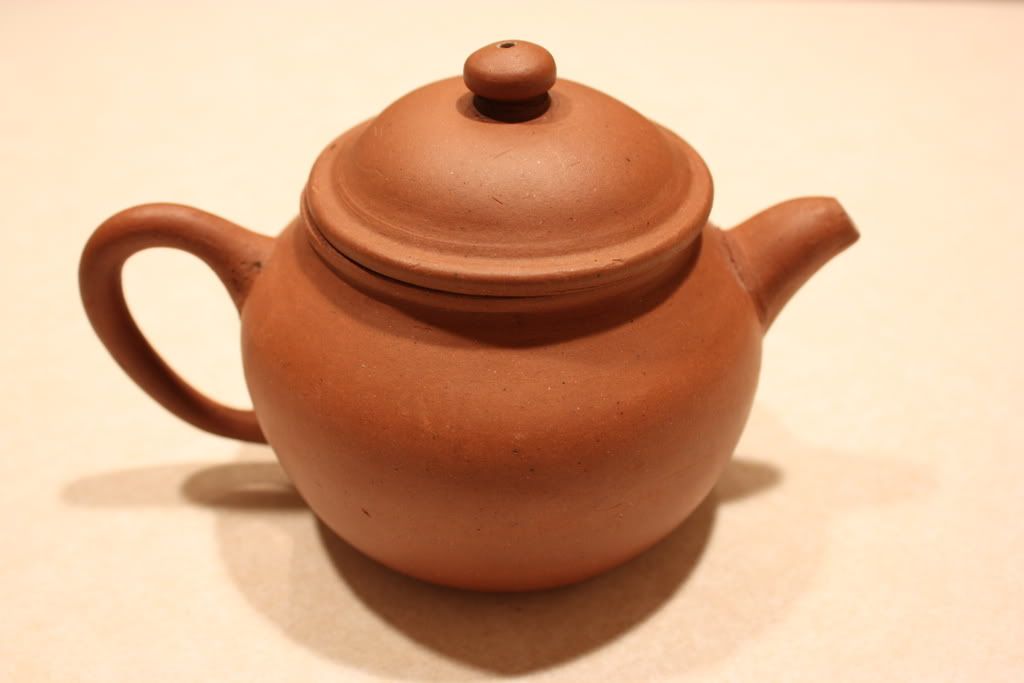
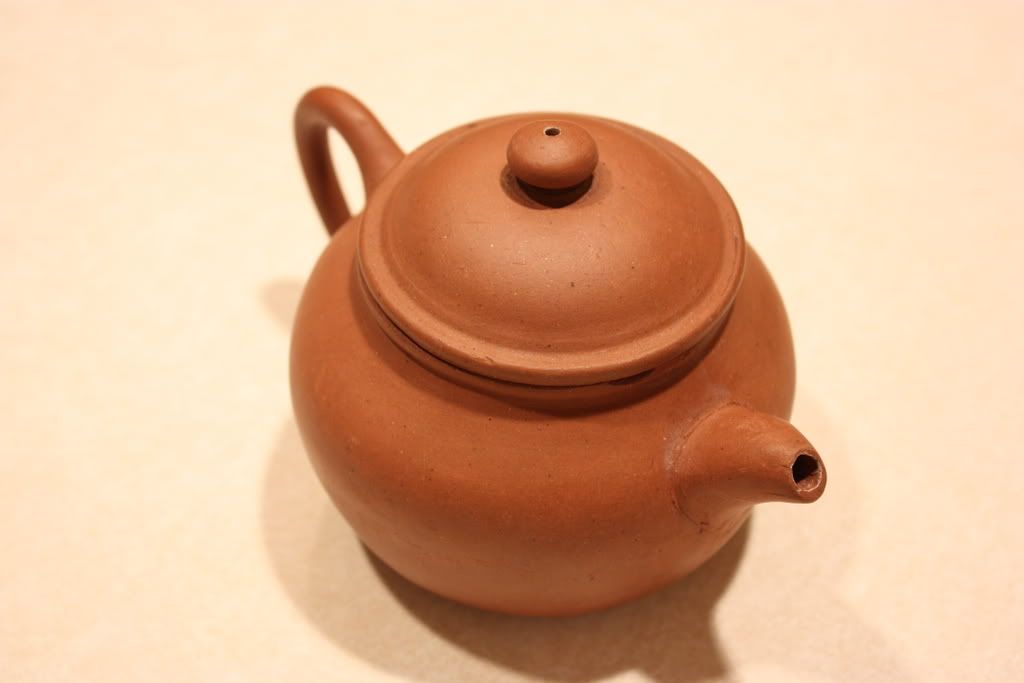
Until you see the inside
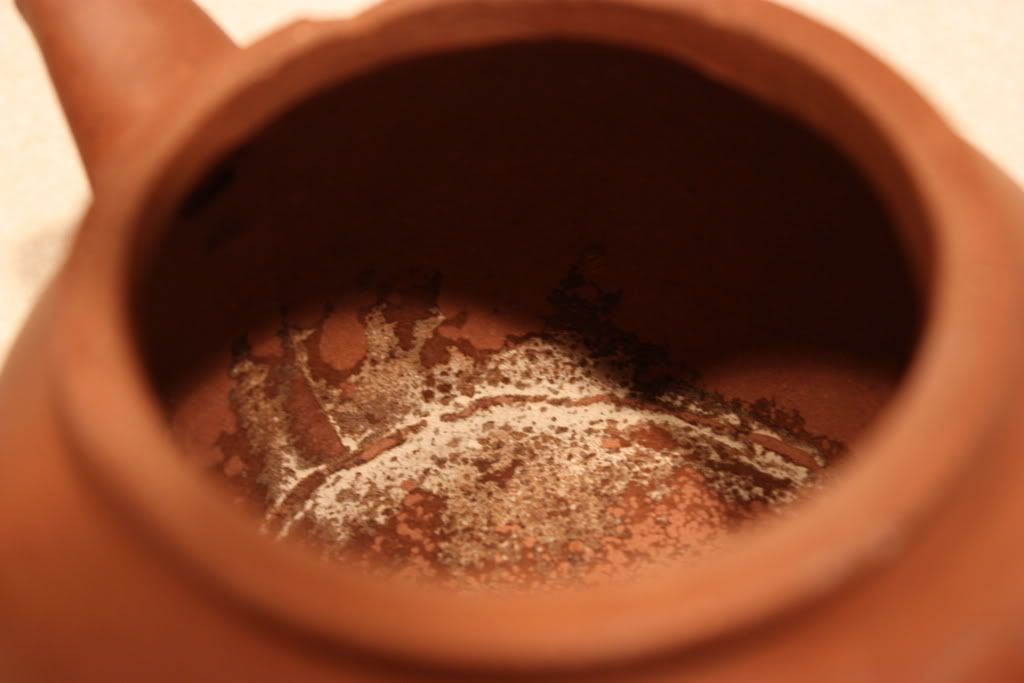

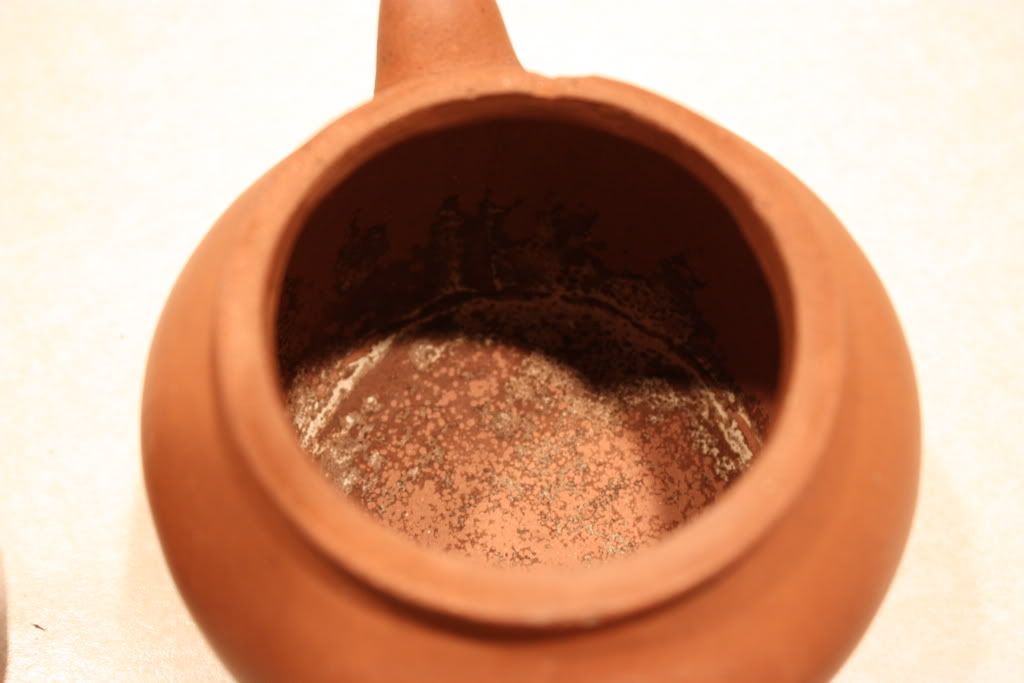
And this is AFTER cleaning it with BLEACH. You don’t want to know what it looked like before — imagine a white covered interior that feels like it is caked on for ages. I have no idea what it is, or how it is so stubborn. I’ve already removed most of it, although you can see how it still has that brown base that makes the whole bottom sort of spotty looking.
How do I clean this thing?
I’ve heard you can use citric acid to melt things away like this, but I’ve never tried it. Aside from that…. what else can I do? I mean, I’m not sure if this pot is really that usable, since it is cracked (although it does not leak — cracking is only on the outside, strangely enough). Either way though, I’d like to at least have it be clean….
Categories: Objects · Old Xanga posts
Tagged: teaware, yixing
A new little thing came in the mail a few days ago

The owner of the pot clearly loved it very much, and used it very, very heavily

And so it took some damage over the years

But because of repeated use — it has the nicest patina I’ve seen in a while

Too bad it is broken… and has a hole in it to boot.
I’m not sure what I will do with it. I got it because it looked like really nice clay, and I wanted a reference pot — something to compare others against, and also, perhaps, something to experiment on. There are simply too many conflicting theories out there on zhuni, what it is, what it isn’t, etc. I think I now have some idea of it should be, but the variation out there makes it hard to say with certainty whether a pot is or isn’t real zhuni, especially, of course, if you only see a picture of it. In some ways, buying a broken pot might be the best bet of getting the real deal.
Categories: Objects · Old Xanga posts
Tagged: teaware, yixing

















 RSS - Posts
RSS - Posts
Interesting.... would 250C in my oven work?